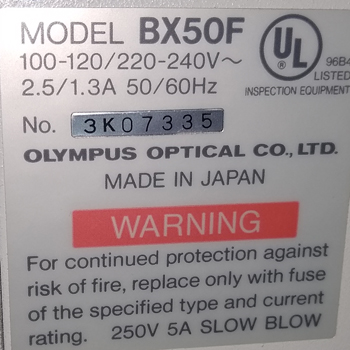My Olympus BX50 microscope
All microphotos, which I show here on my website, were taken using with an Olympus BX50 microscope. I bought this microscope in May 1994, shortly after I had started with the investigation of the Simmelried in July 1993. This microscope was launched by Olympus in 1993 and has infinity optics.
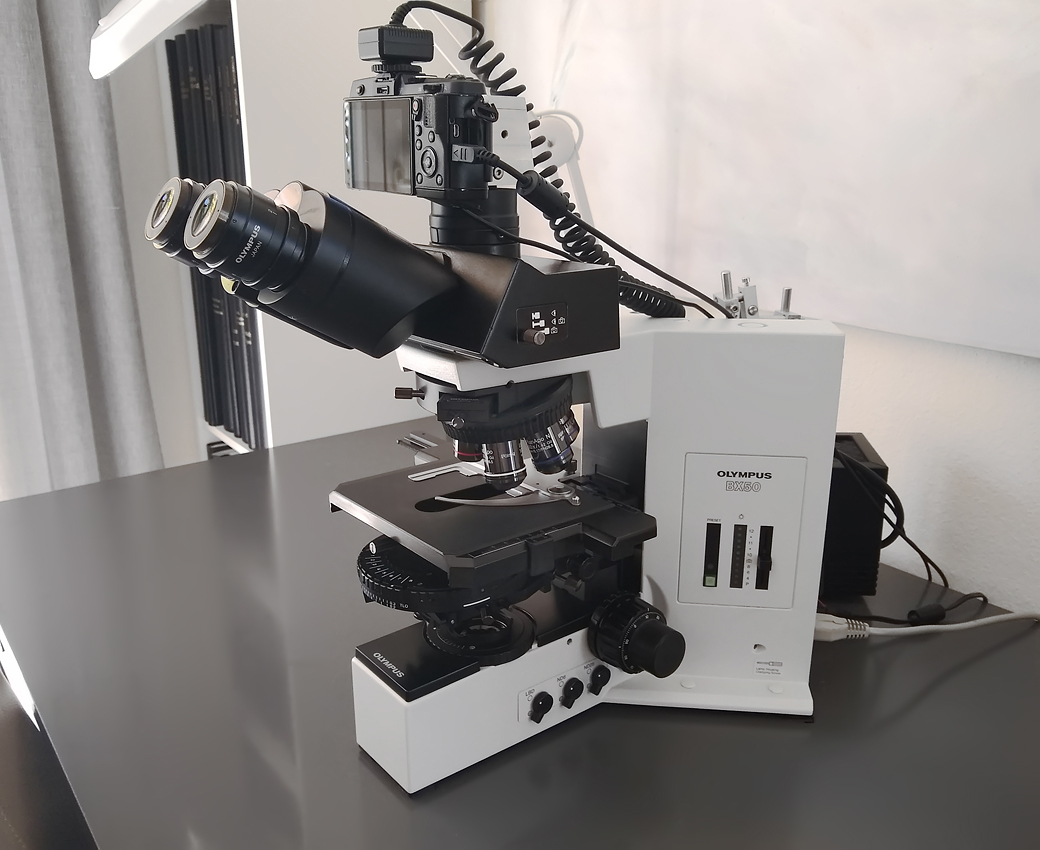
Fig. 1: The Olympus BX50 microscope, which I have had in use since May 1994, image from September 2022.
When selecting the optical and mechanical equipment of the microscope, I paid particular attention to what I had in mind as the main purpose of the microscope, namely the observation and photography of freshwater protozoa. For the objectives I chose Universal PlanFluorite objectives, which represent a good compromise between image quality and light transmission. I decided to purchase the following lenses as basic equipment:
– Olympus UPlanFl 4X/0.13
– Olympus UPlanFl 10X/ 0.30
– Olympus UPlanFl 20X/0.50
– Olympus UPlanFl 40X/0.75
– Olympus UPlanFl 100X/1.30
The microscope was equipped with the standard, so called “ordinary” Olympus DIC from the beginning. This consisted of the following components (s. fig. 2):
– Condenser BH2-UCD, n.A. 0.2 – 0.9, 5 positions
– Olympus DIC prism U-DP10
– Olympus DIC prism U-DP20
– Olympus DIC prism U-DP40
– Olympus DIC prism U-DP100
– Olympus Normarski DIC slider U-DICT
– Olympus U-ANT polarizer (Analyzer)
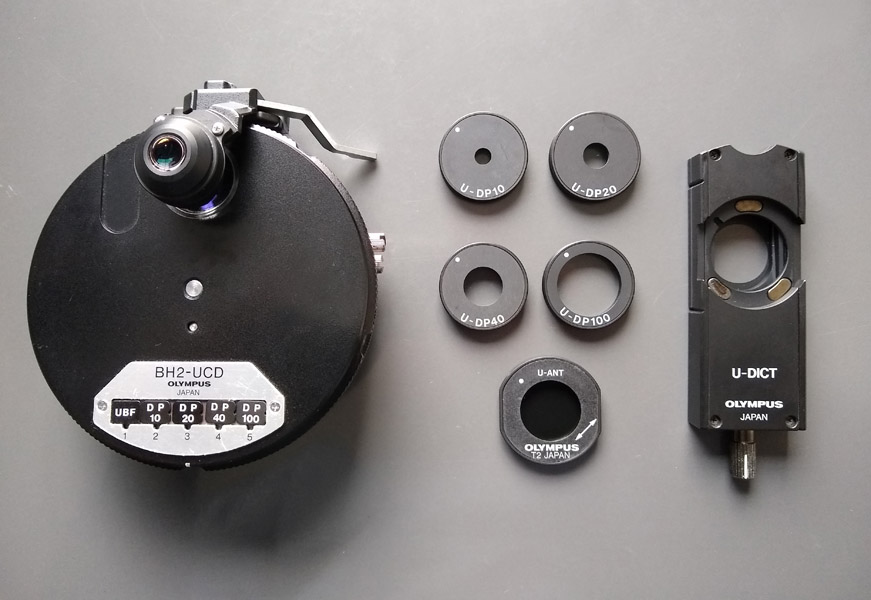
Fig. 2: The Olympus condensor BH2-UCD with “ordinary” DIC equipment.
For better tracking of fast objects and for the adaptation of a camera I decided to use the superwide trinocular observation tube Olympus U-SWTR, with eyepieces Olympus SWH10X-H FN 26.5. For microphotography it is important to align the objects optimally. Therefore the stage should be rotatable. I chose the Olympus U-SVLDB mechanical stage. Furthermore, I decided to use the U-D6RE revolving nosepiece with 6 positions to have the opportunity to add an additional objective later on.
I started with this basic equipment. However, I have made many changes to the configuration of the microscope, partly for reasons of optimization, but also to take advantage of new technical possibilities. In the following I would like to shed some light on this history. Below I have also included a table with a chronological listing of all changes made (s. tab. 1 below).
_______________________________________________
In June 1994 I adapted a 35 mm Olympus OM-2n camera to enable microphotography. I connected it to the BX50 trinocular tubus via the Olympus U-SPT phototubus and an Olympus OM photomicro adapter L (s. fig. 3).
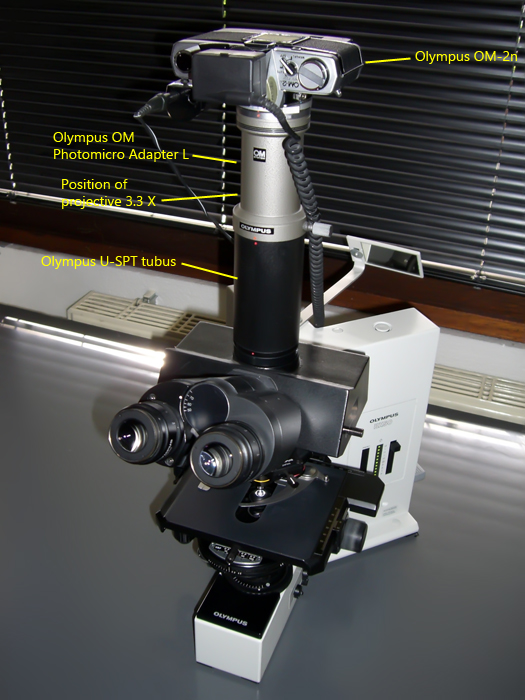
Fig. 3: Adaptation of the Olympus OM-2n camera via the Olympus U-SPT tube and the Olympus OM photomicro Adapter L. A photo eyepiece 3.3 X is inserted into the U-SPT adapter, for projection of the image onto the photo plane. June 2006.
First, I used this camera adaptation without a flash device, but this only allowed me to take images of stationary objects. Therefore I looked for a flash device which could use the TTL automatic flash control of the Olympus OM-2n camera. This was finally realized by the double collector of Jürgen Stahlschmidt, who designed and built it (s. Literature, Stahlschmidt 1987 and 1991). This included a converted Metz Mecablitz SCA 300, also provided by Jürgen Stahlschmidt (s. fig. 4).
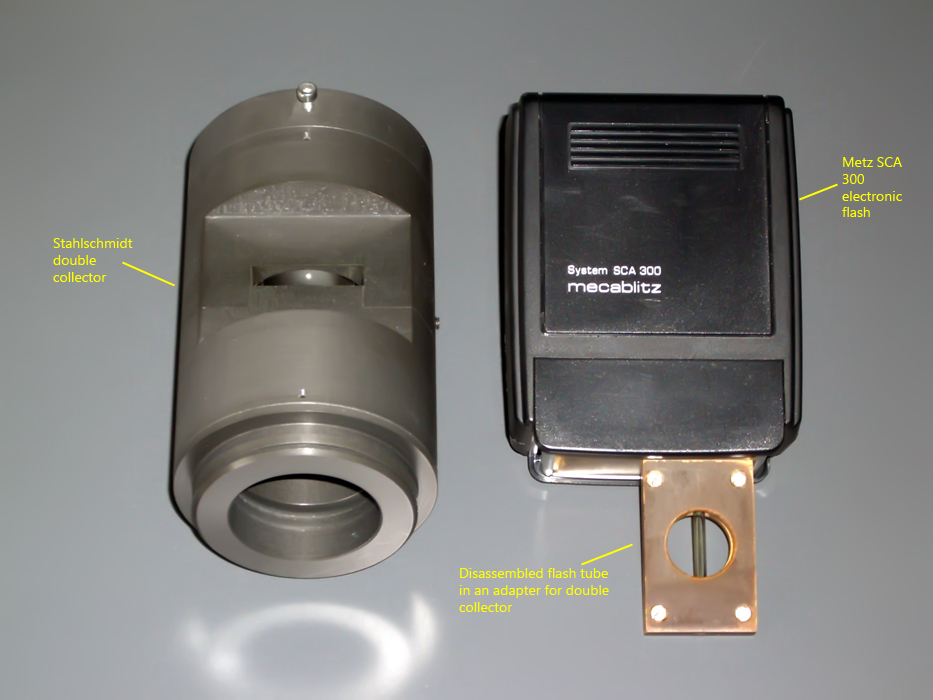
Fig. 4: The Stahlschmidt double collector and the converted Metz SCA 300 electronic flash.
The Stahlschmidt double collector is inserted between the lamp house and the light entrance opening of the microscope. The adapter with the flash tube inside (s. fig. 4) is plugged in, whereby it is now integrated in the light path of the microscope under Köhler conditions. Finally, the flash is connected to the camera with an Olympus TTL cord FL-CB05, allowing automatic, TTL-controlled exposure (s. fig. 5). The camera was triggered via an Olympus RM-UC1 cable release, which was connected to a foot release via solder joints. With this equipment, microflash photography was possible for me since 09-Feb-1995. I used the constellation shown in fig. 5 in an unchanged configuration until March 2007.
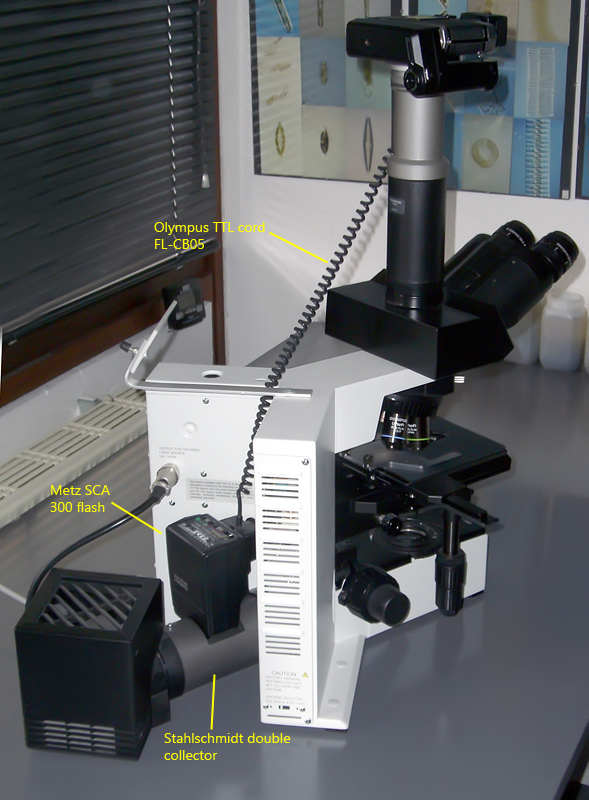
Fig. 5: The Olympus BX50 microscope with adapted Stahlschmidt double collector, electronic flash and Olympus OM-2n camera connected via a TTL cord FL-CB05 with the flash. June 2006.
When photographing protozoa of different sizes, it makes sense to use a broad range of objectives with different magnifications to always get the objects as large as possible on the film plane. In June 2006 I decided to fill my so far free position on the revolving nosepiece with an Olympus PlanApo 60X/0.9 with cover glass correction. I have been using this lens since 26-Jun-2006. It is particularly suitable for objects that are close to the edge of the coverslip and where it is difficult to work with oil immersion.
With the introduction of the digital cameras, I started planning to switch to a digital camera in 2006. Digital cameras were offered with different image sensor sizes. Strongly represented were cameras with a sensor size of about 17 X 13 mm, which is called the four third standard. I chose the Olympus E-400 camera, to replace my previous Olympus OM-2n on 09-Mar-2007. This model can also perform TTL control of a connected flash without a lens, which was a decisive criterion for me. Furthermore, due to the small four third image sensor of the Olympus E-400 with high pixel density (10.0 megapixels effective), this camera was suitable to use the intermediate image of the microscope directly, i.e. without using a photo eyepiece. For this approach, Gerd Günther developed and built the Ergo-DSLR adapter (s. figs. 6 and 7, s. Literature, Günther, 2008), which, thanks to a built-in mirror, enormously reduces the height of the adapter and at the same time allows the camera to be installed in an upright position on the microscope. Due to this design, the display and control panel of the camera is directly at eye level above the eyepieces (s. fig. 7). Convenient control of all camera functions is thus possible. With the aid of this adapter, the image sensor of the camera is now located in the focal plane of the intermediate image of the microscope.
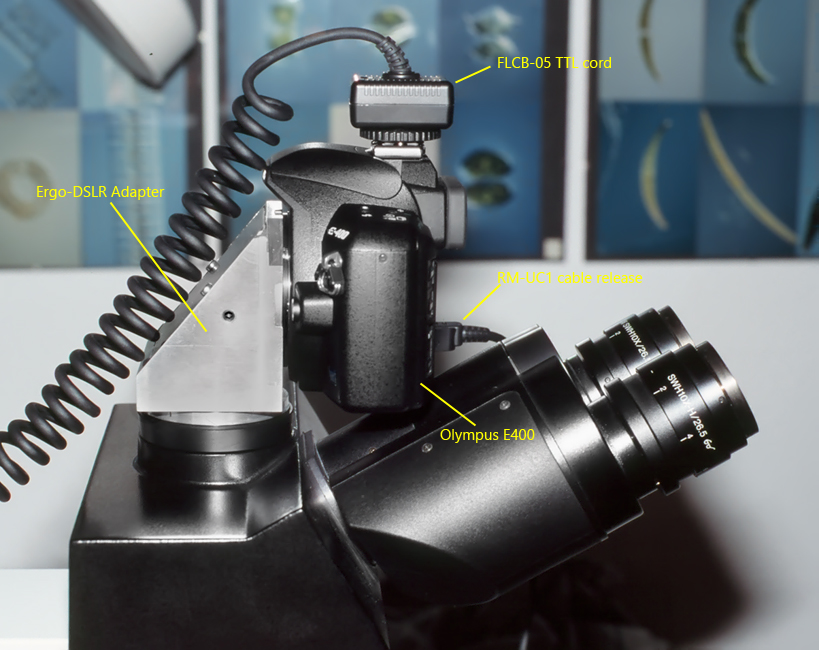
Fig. 6: The Ergo-DSLR adapter with an adapted Olympus E-400 camera. June 2007.
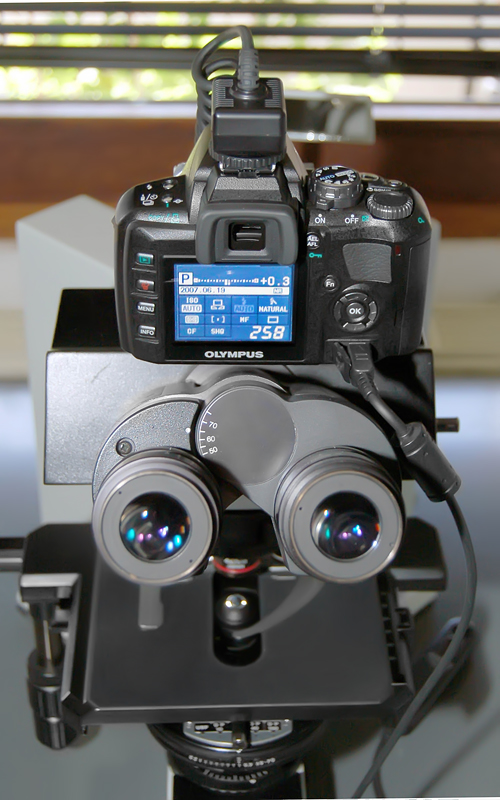
Fig. 7: The Olympus E-400 camera connected via the Ergo-DSLR adapter with the Olympus BX50. June 2007.
The new Olympus E-400 camera could not control the old Metz SCA 32 flash. Therefore, I also had to install a new flash. I decided to use the Olympus FL-36 flash. To integrate the flash tube into the double collector, the flash has to be opened, and the flash tube has to be soldered out and installed into the adapter provided for the double collector. However, the Olympus FL-36 is controlled by the Olympus E-400 using TTL pre-flash technology. This means that a pre-flash is released before the main flash. The light reflected back from the pre-flash is used by the exposure metering system of the camera to calculate the final exposure time of the main flash. To control this process, a photodiode is built into the flash, which must be integrated into the adapter for the double collector together with the flash tube (s. Literature, Kreutz and Miller, 2008). After rebuilding the Olympus FL-36 flash (s. fig. 8 a-b), I was able to take my first flashed, digital microphotos with the Olympus E-400 on 25-Mar-2007.
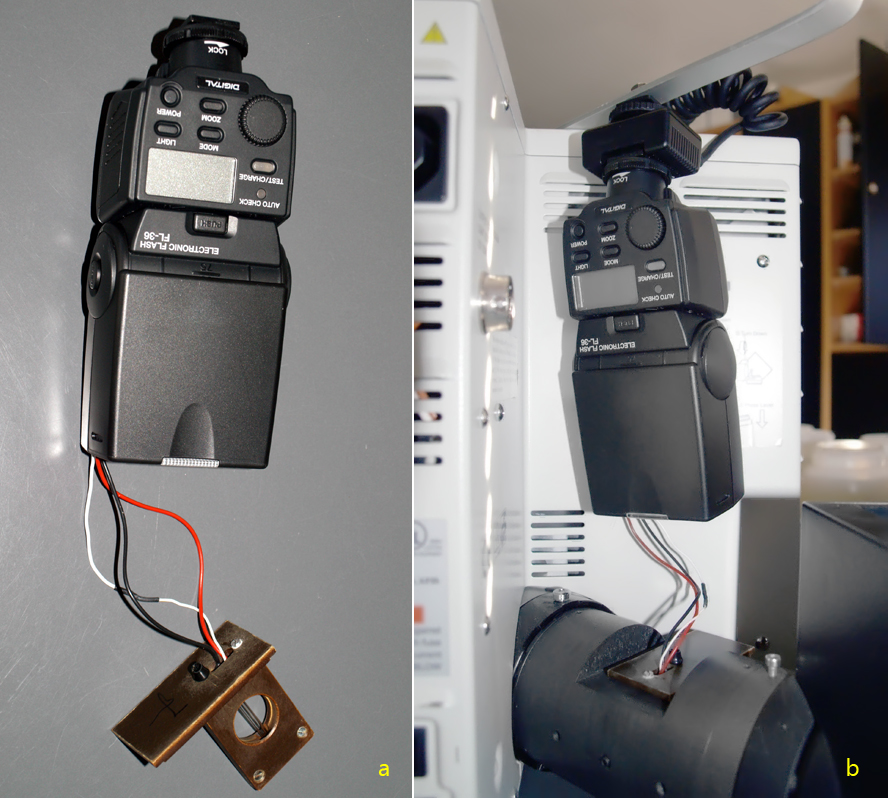
Fig. 8 a-b: The converted Olympus FL-36 flash before (a) and after (b) integration into the double collector.
I used this system until 04-Jun-2010, before I replaced the previous Olympus E-400 with an Olympus E-P1 camera (s. figs. 9 and 10). The new camera had the same geometric size of the image sensor (four thirds format) but 12.3 megapixels (effective) and a better signal-to-noise ratio. The Olympus E-P1 also controlled the Olympus FL-36 flash, so I didn’t have to make any other changes to the system.
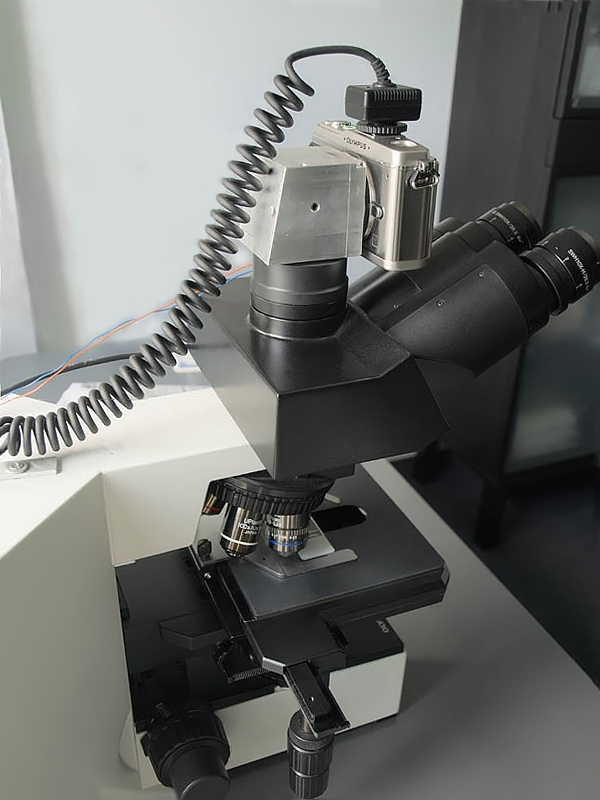
Fig. 9: The Olympus E-P1 camera connected to the Ergo-DSLR adapter.
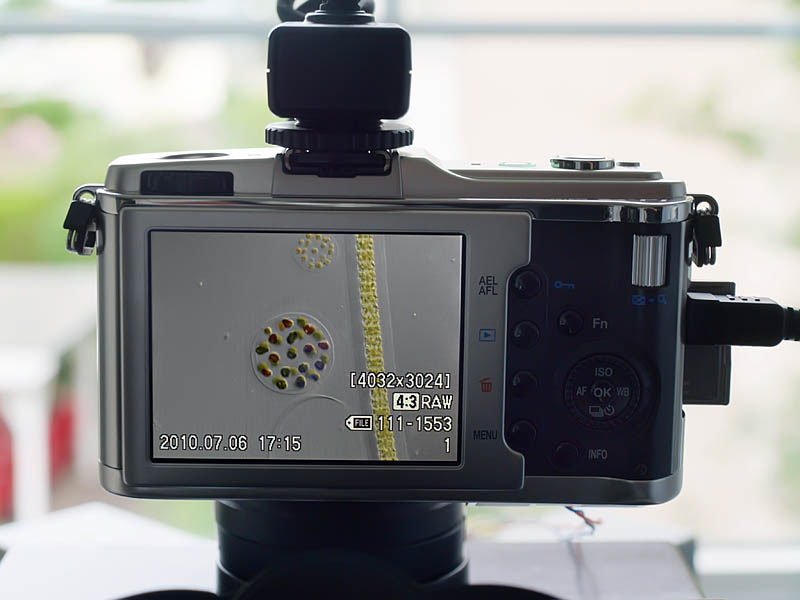
Fig. 10: Display and control panel of the adapted Olympus E-P1 camera.
After about 6 years, I replaced the camera again on 16-Apr-2016, with the newer model Olympus E-P5 (s. figs. 11 and 12). This camera is also equipped with a four thirds image sensor, but with 16.1 megapixels (effective). This camera also controls the Olympus FL-36 without any problems, so I did not have to make any further changes to the system. I still use the Olympus E-P5 today.
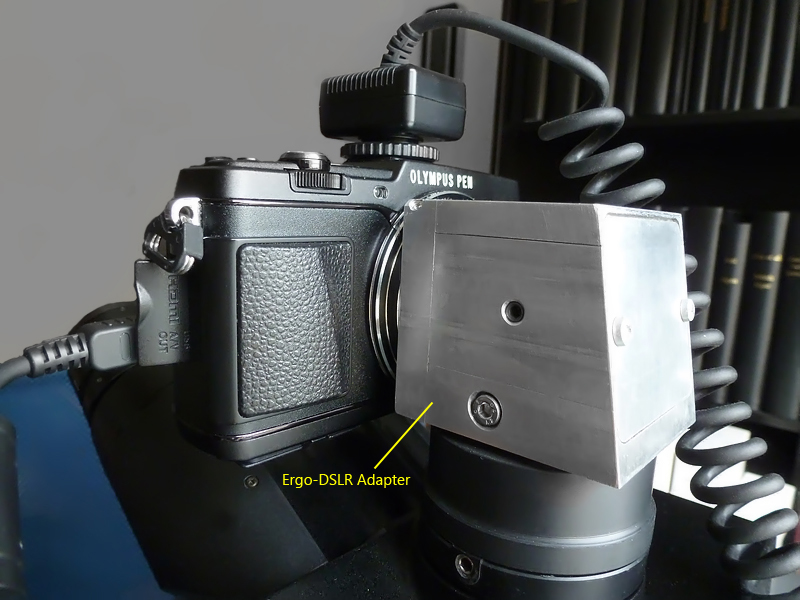
Fig. 11: The Ergo-DSLR adapter with an adapted Olympus E-P5 camera. April 2016.
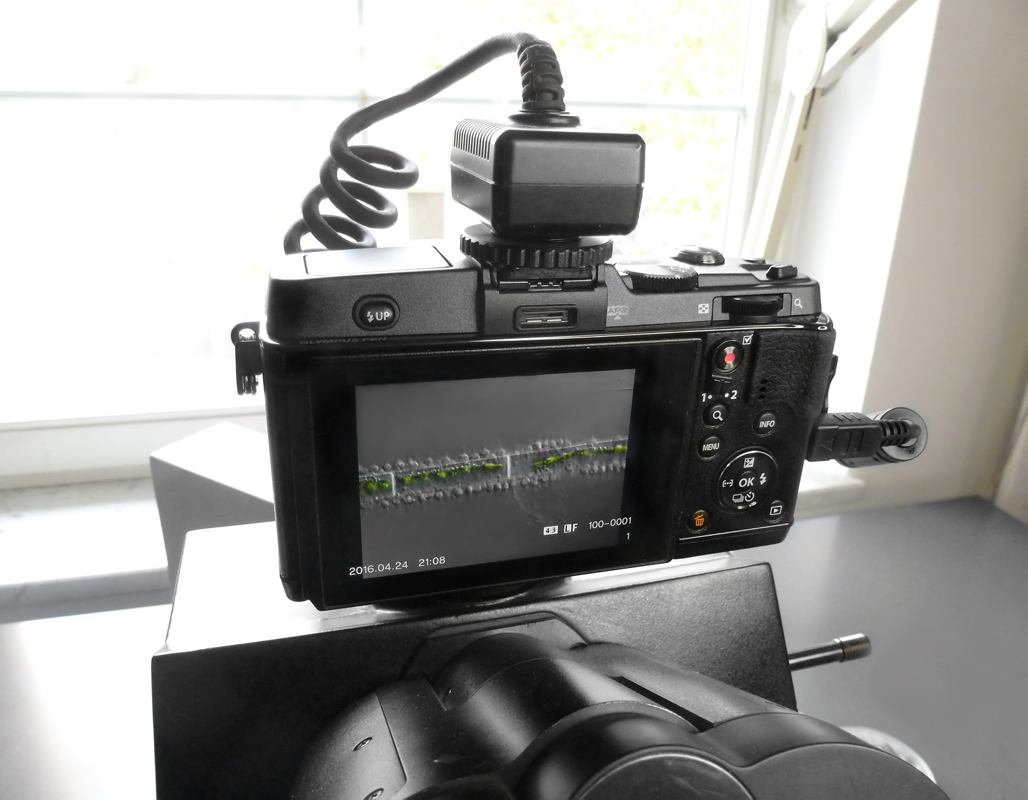
Fig. 12: View of the display and control panel of a Olympus E-P5 camera connected on to the Ergo-DSLR adapter. April 2016.
In 2018, I began considering replacing my previous Olympus BH2-UCD dry condenser n.a. = 0.9 by a condenser providing an aperture of n.a = 1.4. Working with a dry condenser is convenient and fast, but you can’t take full advantage of the aperture of objectives with an n.a. > 0.9. Because I use the 100 X objective a lot, adjusting the illumination aperture was useful and necessary. It turned out that the Olympus BH2-UCD condenser could not be upgraded to n.a. = 1.4 by a new top lens (not offered by Olympus). Therefore, on 28-Jan-2019 I bought the Olympus U-UCD8 condenser with a top lens n.a. = 1.4. This condenser has 8 positions for DIC prisms and filters. However, due to the increased illumination aperture, I could no longer use my previous “ordinary” DIC prisms and DIC slider. When trying to obtain the necessary prisms and slider for the “ordinary” DIC from Olympus, I found that they were no longer available for purchase or had never been offered by Olympus. As an alternative, I bought a used DIC equipment for high resolution DIC, which was offered by Olympus as DIC-HR. The complete equipment to realize the high resolution DIC-HR includes the following components (s. fig. 13):
– Olympus condenser U-UCD8, n.a. 1.4, 8 positions
– Olympus Normarski DIC slider DICTH
– Olympus DIC Prism U-DP10HR
– Olympus DIC Prism U-DP20HR
– Olympus DIC Prism U-DP40HR
– Olympus DIC Prism U-ODPO60HR
– Olympus DIC Prism U-ODP100HR
– Olympus U-ANT Polarizer (Analyzer)
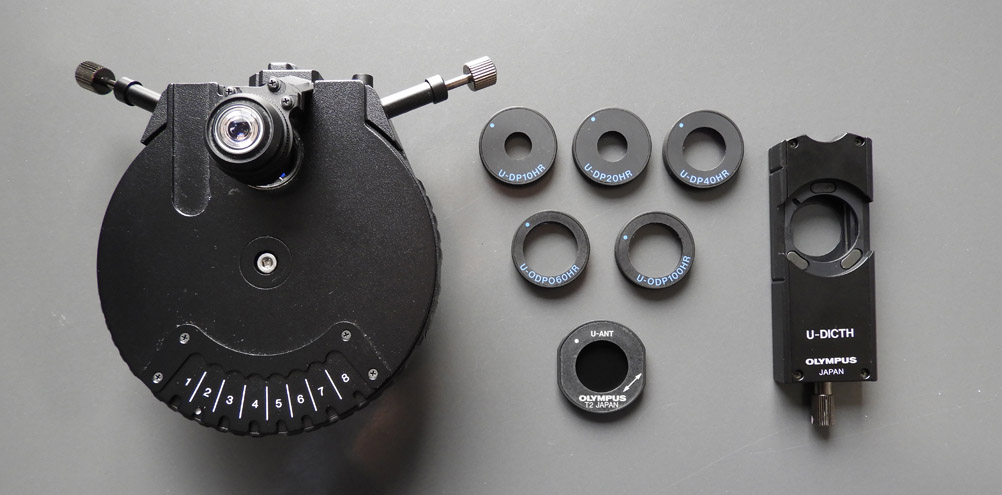
Fig. 13: The Olympus condensor U-UCD8 with DIC-HR equipment.
With the new condenser U-UCD8 I was able to use high aperture objectives in conjunction with the high resolution DIC. Therefore, on 29-Oct-2021 I decided to replace the previous objective UPlanFl 20X/0.50 by the Olympus PlanApo N 60X/1.42 Oil (s. fig. 14). This objective has superior optical qualities and I subsequently decided to also replace my previous UPlanFl 100X/1.30 Oil on 17-Dec-2021 with the Olympus UPlanSApo 100X/1.40 Oil (s. fig. 14). These two high aperture objectives are from the Olympus UIS2 series.
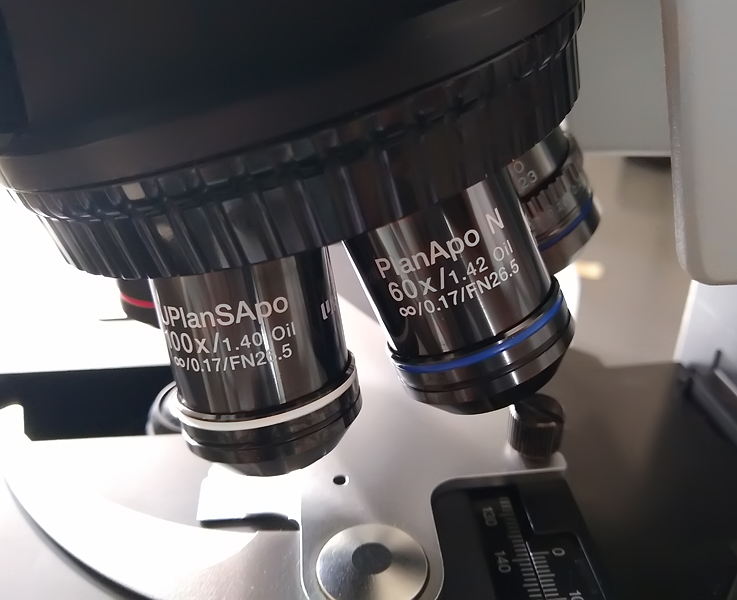
Fig. 14: The high aperture objectives Olympus PlanApo N 60X/1.42 Oil and Olympus UPlanSApo 100X/1.40 Oil provide an excellent image quality. They are my most frequently used objectives.
I have been using the Stahlschmidt double collector for over 25 years. It allows the integration of the flash tube into the beam path under Köhler conditions. The disadvantage, however, is that for this purpose the flash tube must be removed from a commercially available flash and installed in a small adapter. With analog flashes this was easy. However, it is more difficult with the newer flash models, which often have additional sensors that are located on circuit boards and cannot be easily removed. Therefore, the goal is to use a commercially available flash without any modification. For this purpose, Jürgen Stahlschmidt designed and built a mirror box that can be optimally integrated into the Y-stand of the BX50 (s. fig. 15). The flash is placed from above and then mirrored into the beam path under Köhler conditions. Using a lever on the side, the light from the microscope illumination can be reduced to 100 % (reflected for observation) or to 30 %, in which case 70 % of the flash power is reflected in the microscope.
Already during the first test exposures with the mirror box on 20.07.2022 I could notice a higher light output of the flash light. I was able to increase this light output even more after removing the Fresnel lens, which is installed in front of the flash tube on all commercially available flash units. The flash I use is an unconverted Olympus FL-36, the same model I have been using since 2007.
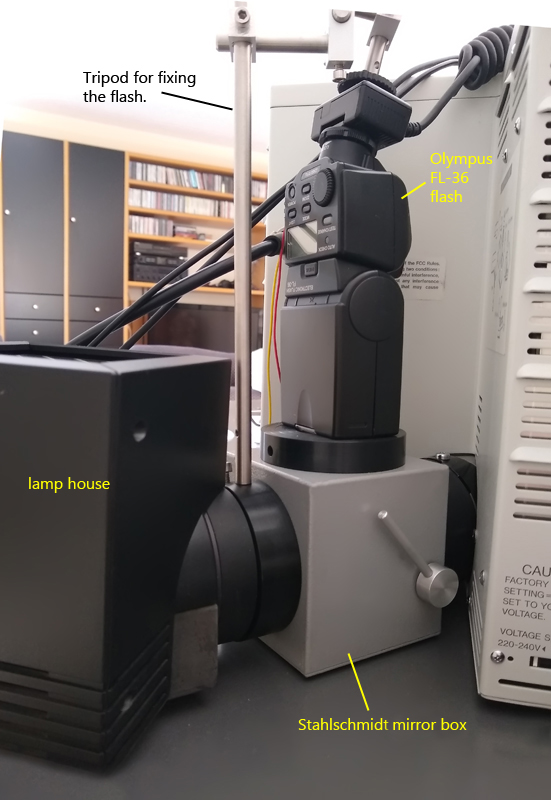
Fig. 15: The integrated mirror box designed and built by Jürgen Stahlschmidt with the Olympus FL-36 flash positioned above the light entry window.
On 14-Nov-2022 I replaced the Olympus FL-36 flash for a Godox TT685 flash (s. fig. 16). The Godox TT685 delivers about twice the light intensity with shorter charging times. TTL control via the Olympus E-P5 camera works perfectly. Since the Godox TT685 has a larger Fresnel lens in front of the flash tube than the Olympus FL-36, the illumination of the image field is subjectively somewhat better. However, the main advantage is the shorter firing time of the flash and the faster charging time. Even with the 100 X lens and the DIC set to high contrast, the charging time after a flash is about 0.1 – 0.5 seconds.
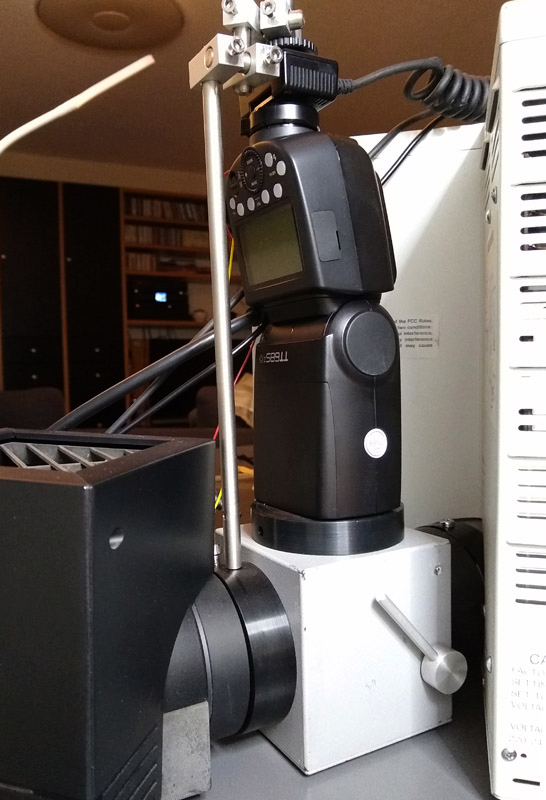
Fig. 16: The Godox TT685 flash positioned above the light entry window of the Stahlschmidt mirror box.
Tab. 1: History of the Olympus BX50 configuration.
History Olympus BX50 microscope Setup on 17-May-1993: BX50 tripod, lamp housing 100 W U-LH100, objective nosepiece U-D6RE, mechanical stage U-SVLDB, Obj. UPlanFl 4X/0.13, Obj. UPlanFl 10X/ 0.30, OBj. UPlanFl 20X/0.50, Obj. UPlanFl 40X/0.75, Obj. UPlanfl 100X/1.30, condensor BH2-UCD, DIC prism U-DP10, DIC prism U-DP20, DIC prism U-DP40, DIC prism U-DP100, Polarizer U-Ant, DIC slider U-DICT, darkfield condensor U-DCD, trinocular oberservation tube U-SWTR, eyepieces SWH10x-H, phototube U-SPT, projective PE 3.3X, Olympus OM Photomicro Adapter L, camera Olympus OM-2n Nameplate:
| |||
Component | Added | Removed | Replaced |
| Stahlschmidt double collector | 02-Feb-1995 | ||
| Metz SCA 300 flash | 10-Jul-1995 | ||
| Olympus objective PlanApo 60X/0.90 | 29-Jul-2006 | ||
| Olympus OM-2n camera | 09-Mar-2007 | ||
Olympus E-400 camera + Ergo-DSLR adapter | 09-Mar-2007 | ||
| Metz SCA 300 flash | 26-Mar-2007 | ||
| Olympus FL-36 flash | 26-Mar-2007 | ||
| Osram 100 W halogen bulb | 28-Aug-2008 | ||
| Olympus E-400 camera | 04-Jun-2010 | ||
| Olympus E-P1 camera | 04-Jun-2010 | ||
| Olympus E-P1 camera | 16-Apr-2016 | ||
| Olympus E-P5 camera | 16-Apr-2016 | ||
| Olympus condensor BH2-UCD | 12-Jul-2019 | ||
| Olympus “ordinary” DIC | 12-Jul-2019 | ||
| Olympus condensor U-UCD8 | 12-Jul-2019 | ||
| Olympus high resolution DIC-HR | 12-Jul-2019 | ||
| Olympus objective UPlanFl 20X/0.50 | 29-Oct-2021 | ||
| Olympus objective PlanApo N 60X/1.42 Oil | 29-Oct-2021 | ||
| Olympus objective UPlanFl 100X/1.30 Oil | 17-Dec-2021 | ||
| Olympus objective PlanSApo 100X/1.40 Oil | 17-Dec-2021 | ||
| Stahlschmidt double collector | 20-Jul-2022 | ||
| Stahlschmidt mirror box | 20-Jul-2022 | ||
| Olympus FL-36 flash | 14-Nov-2022 | ||
| Godox TT685 flash | 14-Nov-2022 | ||
